The slums in the City of Angels
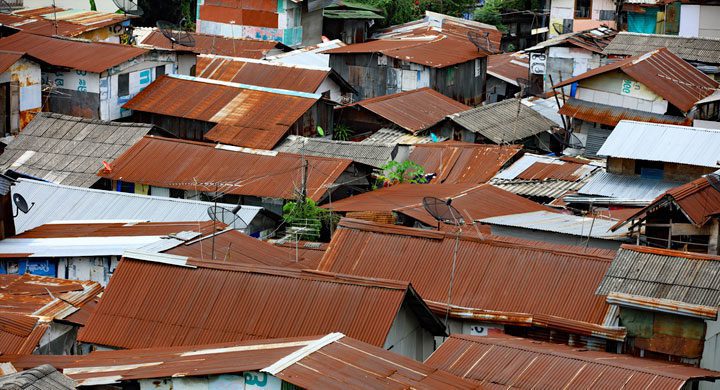
Thailand has a lot to offer both in terms of nature and culture. But there are also many slums behind the temples with golden Buddha statues and next to the shopping paradises. Neighborhoods that are sometimes portrayed as a tourist attraction. What struck me most was the much greater diversity in terms of income and occupations among the inhabitants than I had assumed. Only a small proportion are unemployed and drug-addicted paupers. A brief introduction.
In 2003 there was a meeting of leaders of the Pacific countries in Bangkok. They sailed across the Chao Phraya past a banner welcoming them warmly. That banner was said to be the largest in world history: 360 by 10 meters and it cost a whopping 9 million baht. In this way, the Tha Tien slum on the banks of the river was hidden from view. The neighborhood located just south of the Grand Palace has been threatened many times with eviction in order to improve the tourist image of Bangkok.
What is a slum?
The definition can vary but usually includes the following elements. There is overcrowding with more than 15 houses on a rai (1.600 square meters) and up to 6 residents per house (normally 3+), there is little privacy, the houses are inadequate and the environment is often neglected with a lot of waste, smell and humidity . This definition is partly subjective, which is why the numbers of slums can vary (sometimes a lot).
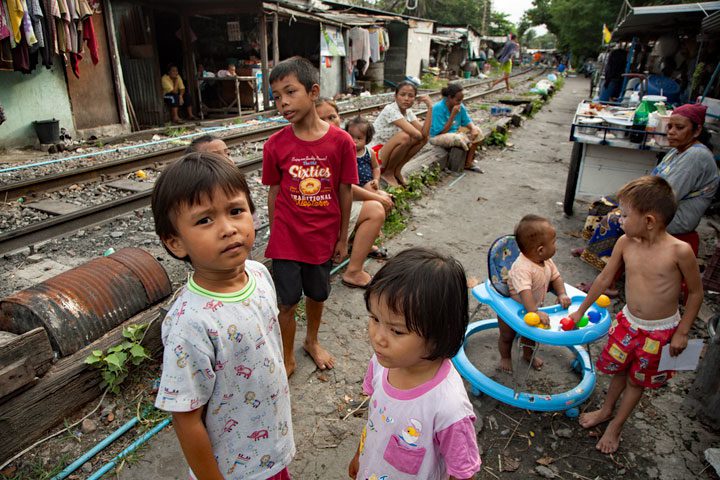
flydragon / Shutterstock.com
The 'slums' in Bangkok
They are spread all over Bangkok but with a concentration close to the center and more on the periphery. Some neighborhoods are small with 10-50 homes, others are large such as Khlong Toei with around 100.000 inhabitants.
There are two types of grades based on different criteria. The Bangkok City Council says there are 1.700 slums in Bangkok with 1.700.000 inhabitants, while the National Housing Association gives a lower number with 800 slums and 1.000.000 inhabitants. The latter figures would mean that 20% of the population lives in a slum. (I round the numbers). Also in the industrialized areas around Bangkok, such as Pathum Thani, Samut Prakan and Samuth Sakhorn, the percentage of inhabitants in slums is between 10 and 20%.
The rest of Thailand
In the rest of Thailand, 1% of the population lives in slums. In the link below there is a good story about slums in Chiang Mai located next to the very polluted Mae Kha drainage channel that runs between the old city center and the Ping River. Although illegal, many hotels and businesses discharge their wastewater into this smelly canal, blaming the slum dwellers.
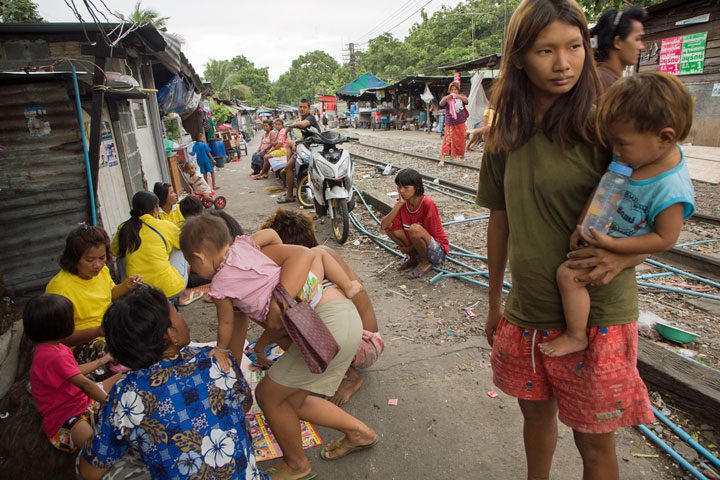
flydragon / Shutterstock.com
Who live there?
That information came as a surprise to me. Many people assume that they are mostly rural people who have emigrated to the city, Isaan farmers living in the city, all poor and uneducated. That hasn't been the case for a long time. More than 70% of the population of slums consists of people who were born and raised in Bangkok.
Although on average the population in these neighborhoods earns less and is less well educated, it is nevertheless very diverse and there has certainly been progress in recent decades.
Most residents of these neighborhoods have work, more often in lower-paying professions and the informal sector, but in the past 20-30 years increasingly in professional activities. They are an important part of the working population in Bangkok.
Average income and level of education
A small portion of the inhabitants have no income and are supported by family, friends and various foundations. The average income in the slums is somewhat higher than in the countryside, but the expenses are quite a bit more. The somewhat wealthier middle class is also represented in the slums. The fascinating question then is why people with a reasonable income continue to live in a slum? They indicate that they do it because they want to live close to their work, have cheap housing and above all do not want to miss out on togetherness.
This image is reinforced when looking at the possessions of the residents. In 2003 it was determined that everyone owned a TV, 65% had a washing machine and a mobile phone, almost half had a scooter and 27% a car, and 15% can afford the luxury of an air conditioner.
The educational situation has also improved: 10% have no education, 50% have only completed primary school, 20% also secondary school and just under 10% have a university education. (Unfortunately these are the last figures from 1993, the situation will have improved again).
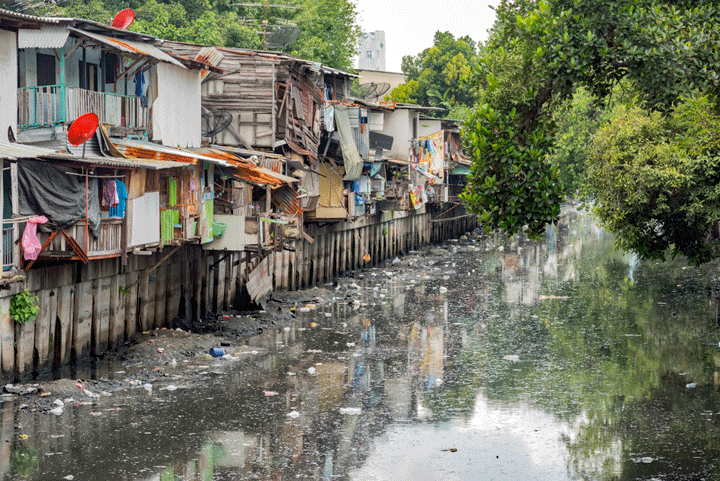
Their living situation
It will be clear that this is where most of the bottlenecks lie. A third of the inhabitants of slums are squatters, land squatters and can be evicted at any time. The land in the Khlong Toei community is owned by the Port Authority and people live there illegally. The founder of the Duang Prateep Foundation says that she has already been deported 6 times and had to find another place to stay each time. A larger group rents land and then builds their own house or rents a house. The rents are usually between 500 and 1000 baht per month, with peaks of 1500 baht.
The houses are very close together, there is a great lack of privacy. While in Thailand a household has an average of just over 3 people, in the slums the average is 6 people. The construction of the houses is simple, often made of wood with a corrugated iron roof. The paths are narrow and uneven.
Most houses have electricity and water. Wastewater disposal is perhaps the biggest problem. There are cesspits, but much of it just flows into the area, which is therefore highly polluted and smelly. Little is done about the drainage of rainwater, which makes the land soggy and sometimes just looks more like a pond. The waste also piles up.
Municipal authorities are often hesitant to improve public facilities because they prefer the slum dwellers to leave.
What has been done about it?
Although more attention has been paid to the poverty problem in rural areas, there have been many initiatives in recent decades to tackle the slum problem. Cheap and subsidized apartment buildings were built. That was often a failure: they were still too expensive, too far from work and without a pleasant social environment. Many people rented it out to others and returned to their slum with an extra income. The eviction of slums also happened, often for the beautification of Bangkok. The residents received monetary compensation but went back to live in a slum elsewhere. It happened too little that the residents were involved in the plans that were imposed from above. Usually they resist.
It also often happens that owners cancel the lease on land and house in order to sell the land. This brings in a lot of money, especially in the central areas of Bangkok.
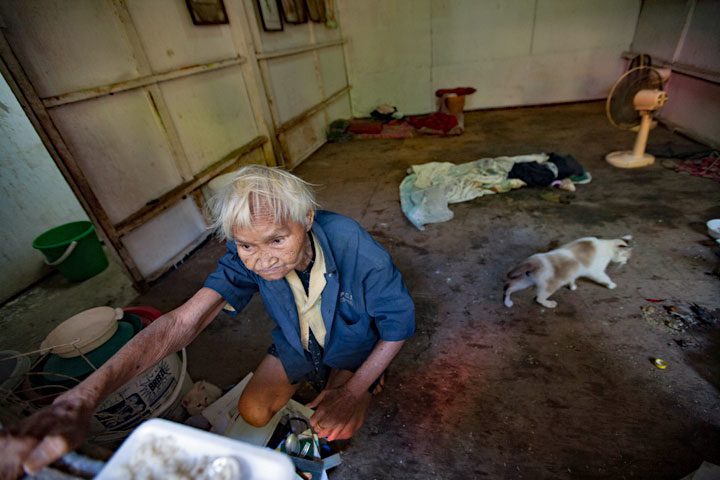
flydragon / Shutterstock.com
The future
Plans for resettlement continue. In addition, the government wants to buy out the landowners and sell the land for a bargain price to the residents who, according to experience, will then invest more in a better living environment. However, the landowners can get a much higher price on the ordinary market.
Most people tend to believe that it is not primarily a housing problem but a general poverty problem with the addition of more or less deliberate neglect of public services by the government.
In 1958 46% of all housing was in slums, now only over 6%. Perhaps a reason for optimism?
Main sources:
https://www.slideshare.net/xingledout/the-eyesore-in-the-city-of-angels-slums-in-bangkok
A walk through the Khlong Toei slum (5 minutes): https://www.youtube.com/watch?v=abEyvtXRJyI
A fascinating short train journey through Khlong Toei with appropriate commentary. To look! (7 minutes): https://www.youtube.com/watch?v=RLKAImfBjsI
About slums in Chiang Mai: https://dspace.library.uu.nl/
About Prateep Ungsongtham and her Duang Prateep foundation, which has existed for 40 years, and which set up many projects, mainly for education, in the Khlong Toei slum. A moving story: en.wikipedia.org/wiki/Prateep_Ungsongtham_Hata
Bangkok Post: www.bangkokpost.com/print/317726/


Good piece Tony. Surprising figures at first, but when you think about it, it's not so strange at all. That is why it is good not to go by the gut, but also to be open about what research, reports, etc. have to say. If you are open to it, you can adapt your ideas to reality.
As for the slums, we see fewer and fewer of them. As the income, social and economic situation of the citizen improves, the excesses (corrugated iron house) will become less and less. Unfortunately, Thailand is the country with the greatest income inequality, so it will take some time before 'every' Thai has a decent roof over his head, a decent income and does not have to live from day to day. Resettlement is not the solution, but as long as filthy rich people at the top choose to cover up the real problems...
Does it relieve the residents who have been land grabbing for generations of their duties? They now know from birth that they can live there by the grace of someone else and that one day they will have to get out of there.
Even without education there is work and you don't have to have a child at 18, but yes, it is so nice in that neighborhood so why would you flee it.
Typical head in the sand mentality where pity is a bit inappropriate.
Compassion and understanding are never inappropriate. As a general practitioner I have helped former SS officers. You told me I should have let them die?
Rather think about solutions.
There is a separation of powers and thoughts.
As a doctor you try to rid a person of a problem and as a legislator you could rid society for good of erroneous SS officers as happened in the Netherlands until the end of March 1952.
I could not live with the idea (and that is why I am not a professional healthcare provider) that people like that should be spared (read: helped) for the suffering they have caused others and which is fortunately still commemorated annually.
Then a bridge can immediately be built, such as that such an SS man accidentally got involved in such a situation and that this also applies to residents of a slum and then you soon find yourself in a victim role.
The solution is that the residents must realize that it is not their property and therefore not complain if the owner needs the land. You give the residents a finger to use the land, but they take two hands when you use your rights.
As described, most of them have normal work and there is certainly a possibility to leave the neighborhood. Apartments from 3000-5000 baht are really for rent, but they prefer to stay where they are so that they have money left over.
As long as migrant workers from Laos, Cambodia and Myanmar live in an apartment in Bangkok, in my opinion the solution must really be sought in the mentality of those slum dwellers.
And I do understand that mentality: In most slums, there are just the necessary facilities, there is a strong social cohesion and it has something cozy, something like the allotments that the Dutch loved to spend the summers in, so go, replace corrugated sheets with bitumen roofs and it will look neat for years to come.
We studied Duang Prateep. What this lady does with her foundation is incredible. Not chatting, but in a practical way every day.
way of trying to help the people in the slum. The simple fact that her Foundation has already produced many graduated doctors and other academics etc from children who originally supposedly did not even (legally) “exist” is unbelievable. But there is much more. This foundation deserves more attention!
So her name is Prateep Ungsongtham with sometimes Hata' behind it because she is married to a Japanese. See the Wikipedia link above.
Very nice of you to put her and her foundation in the spotlight again. Too few 'ordinary' great good Thai people are honored, too much honor goes to 'high-ranking' people.
Write something about her, her foundation and your experiences! That is very important to know!
I quickly read the article, so perhaps it contains the answer to my question, but is there also a middle class and economy in those neighborhoods?
So a 7Eleven, food stalls, massage parlors, etc…?
Sure, Pat. Around 100.000 people live there. The living conditions vary, not all of them are shacks, there are also (very dilapidated) apartment buildings, there is a temple, a police station, a 7-11, schools, many food stalls, a famous large fresh market, a town hall, a metro station. It is a city. I don't know about massage parlors...